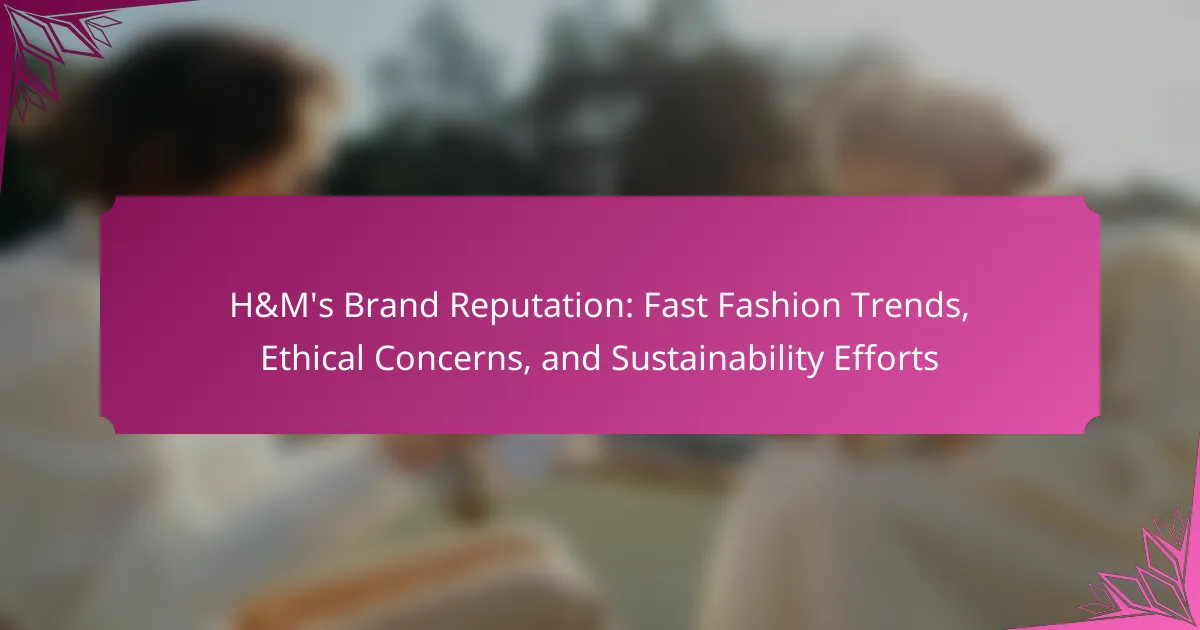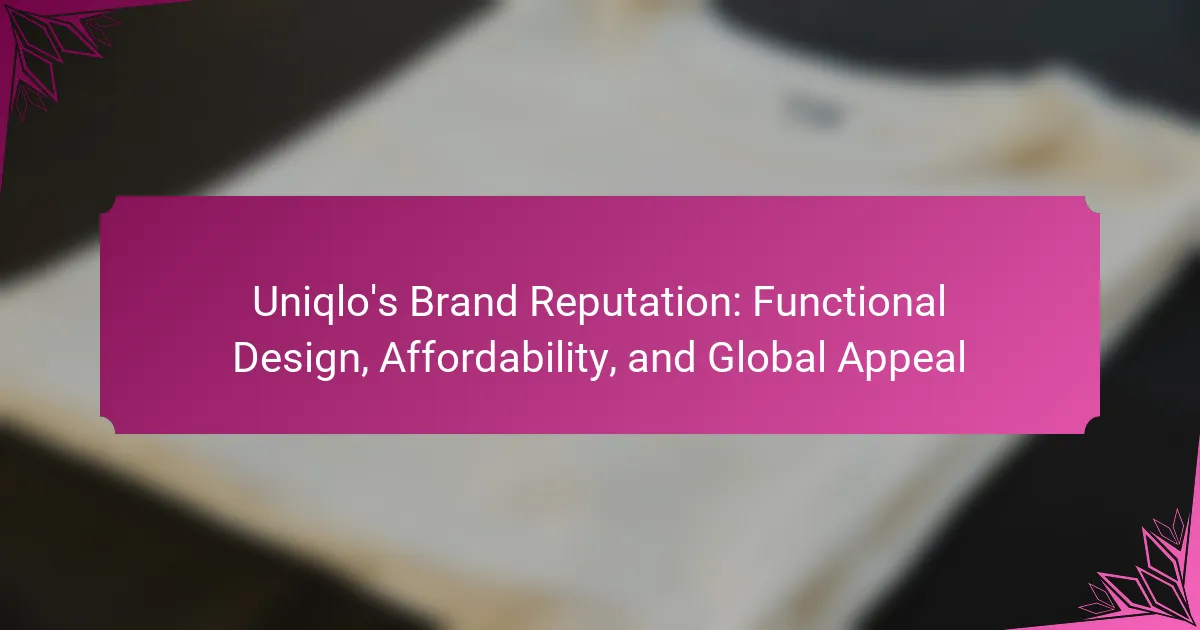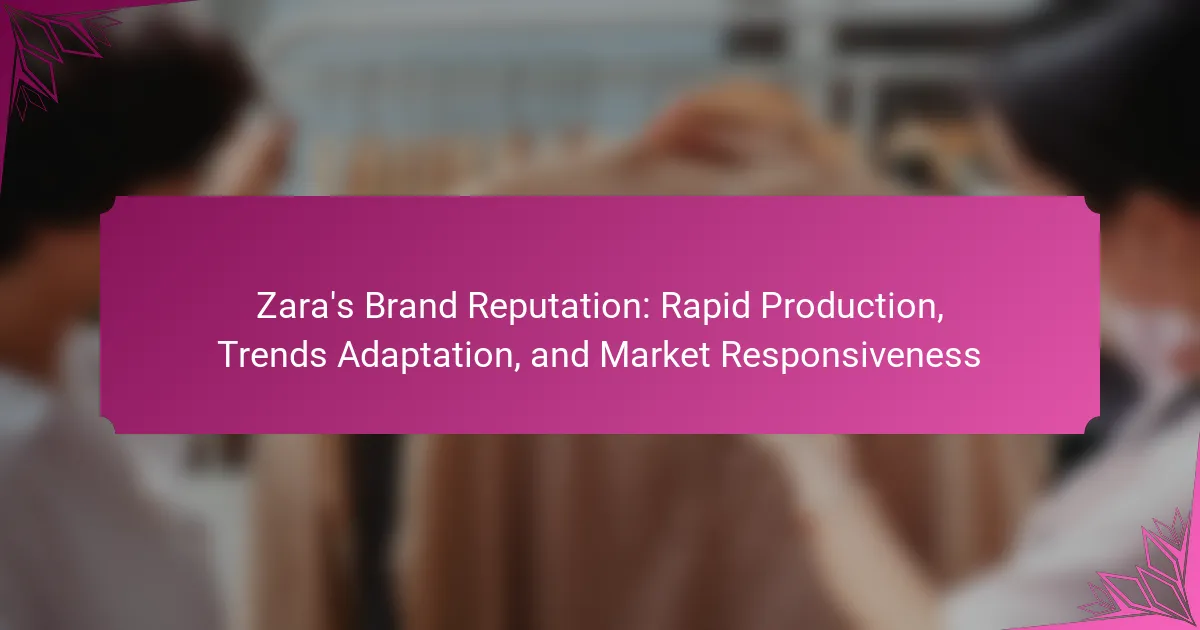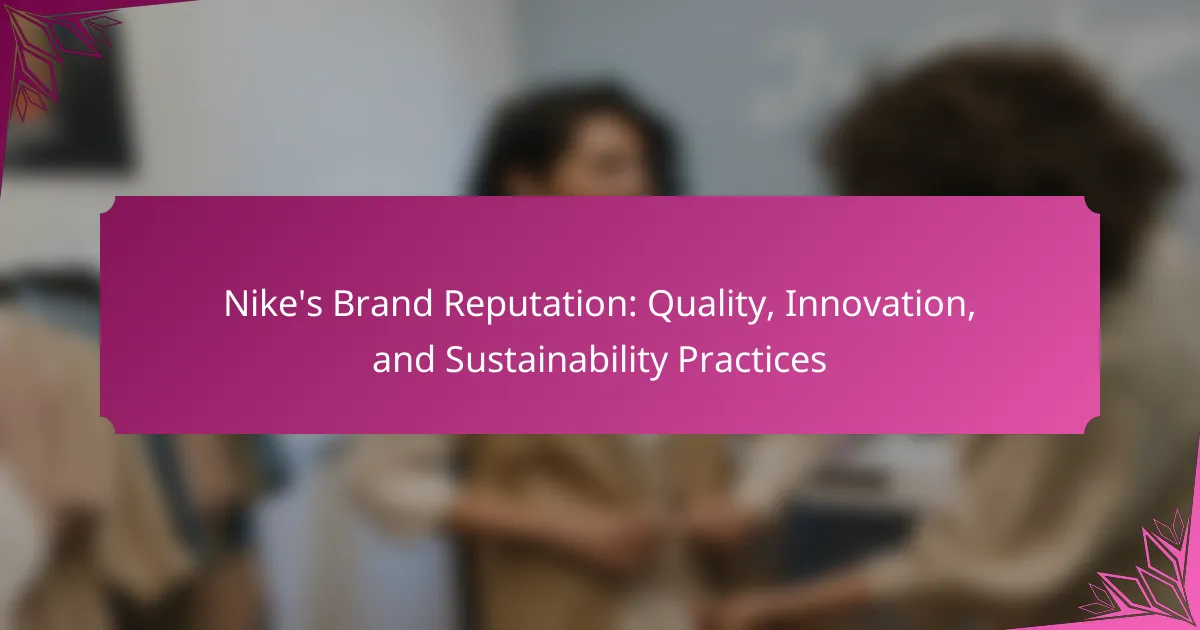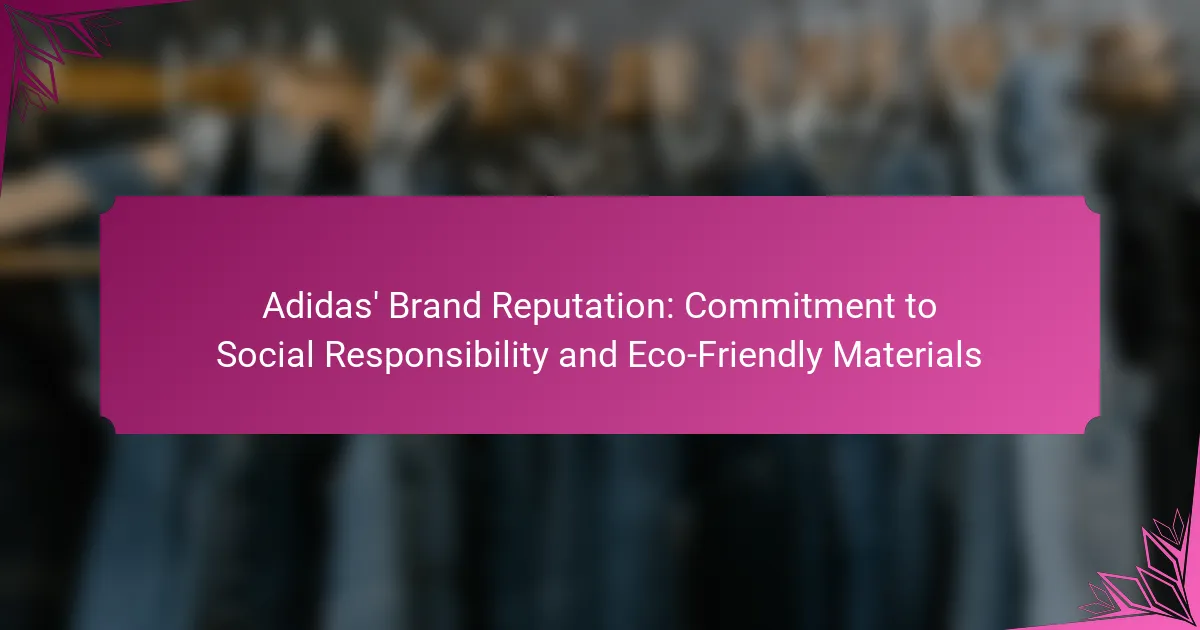H&M is a global fast fashion retailer known for its trendy clothing at affordable prices. The brand is currently navigating a complex reputation shaped by its appeal to consumers and ongoing scrutiny regarding ethical practices, particularly in labor and environmental impact. H&M has made commitments to improve sustainability, aiming for 100% sustainable cotton, linen, and polyester by 2025, and has initiated a garment collecting program to promote recycling. Despite these efforts, consumer skepticism remains regarding the brand’s ethical commitment, although recent trends indicate a growing preference for sustainable fashion. The article will explore H&M’s brand reputation in relation to fast fashion trends, ethical concerns, and its sustainability initiatives.
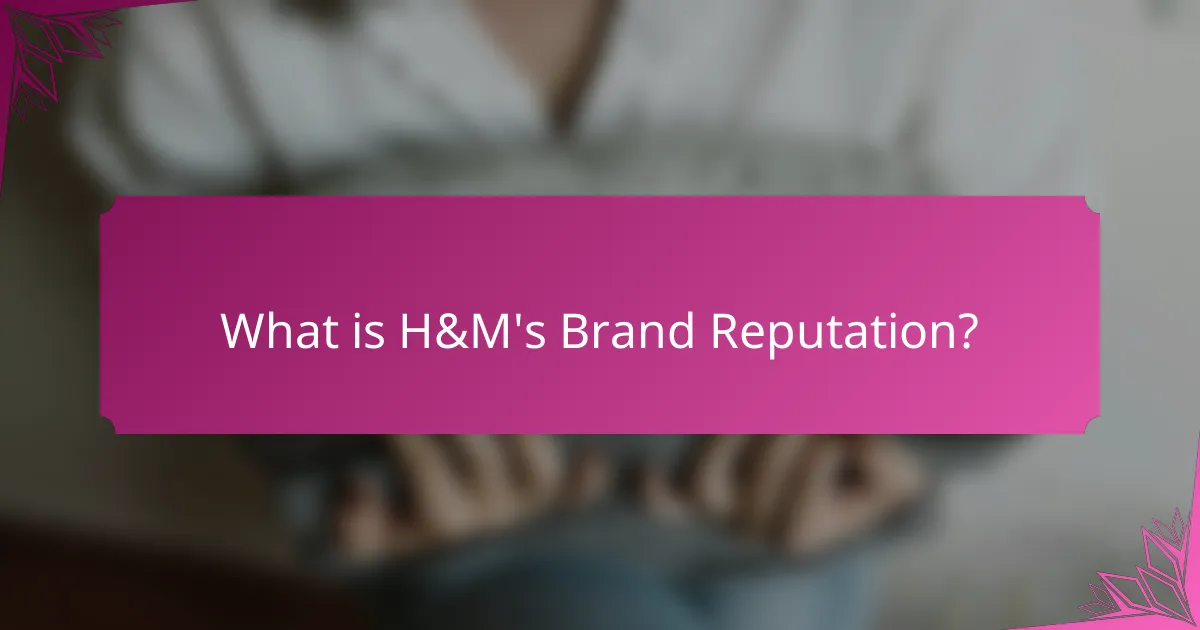
What is H&M’s Brand Reputation?
H&M’s brand reputation is a complex mix of fast fashion appeal and ethical scrutiny. The brand is known for offering trendy clothing at affordable prices. However, it faces criticism regarding labor practices and environmental impact. Reports indicate that H&M has made efforts to improve sustainability. The company aims to use 100% sustainable cotton by 2025. Despite these initiatives, many consumers remain skeptical about its commitment to ethical practices. Surveys show that a significant portion of shoppers prioritize sustainability in their purchasing decisions. Overall, H&M’s reputation is influenced by both its market presence and ongoing ethical challenges.
How has H&M’s brand reputation evolved over time?
H&M’s brand reputation has evolved significantly over time. Initially, H&M was celebrated for its affordable fashion offerings. The brand gained popularity for its trendy styles and rapid production cycles. However, over the years, it faced criticism regarding labor practices and environmental impact. Reports highlighted poor working conditions in factories and the fast fashion model’s contribution to waste. In response, H&M launched sustainability initiatives, such as the Conscious Collection. The brand aims to improve its environmental footprint by using organic materials and promoting recycling. Recent surveys indicate a gradual improvement in public perception as consumers recognize these efforts. However, challenges remain as the fast fashion industry continues to be scrutinized.
What key events have influenced H&M’s reputation?
H&M’s reputation has been influenced by several key events. In 2013, the Rana Plaza disaster, which involved the collapse of a garment factory in Bangladesh, drew attention to the unsafe working conditions in the fast fashion industry. H&M faced criticism for its supply chain practices in the aftermath. In 2018, H&M launched its Conscious Collection, aimed at promoting sustainability. This initiative was part of a broader strategy to improve its image amid growing ethical concerns. In 2020, H&M was criticized for its handling of unsold inventory, leading to allegations of wastefulness. The company’s response to these events has shaped public perception significantly.
How do consumer perceptions shape H&M’s brand image?
Consumer perceptions significantly shape H&M’s brand image by influencing public opinion and purchasing behavior. Positive perceptions of H&M’s affordability and trendy styles attract customers. However, negative perceptions regarding fast fashion and sustainability concerns can deter potential buyers. Research shows that 66% of consumers consider sustainability when making fashion purchases. H&M’s efforts in promoting eco-friendly initiatives aim to counteract negative perceptions. The brand’s commitment to using recycled materials and reducing waste is essential for improving its image. Additionally, consumer feedback on social media platforms can rapidly alter H&M’s reputation. Thus, consumer perceptions are pivotal in defining H&M’s brand identity in a competitive market.
What role does fast fashion play in H&M’s brand reputation?
Fast fashion significantly impacts H&M’s brand reputation. H&M is known for its rapid production of trendy clothing at low prices. This business model attracts a large customer base seeking affordable fashion. However, fast fashion has raised ethical concerns regarding labor practices and environmental sustainability. Critics argue that H&M’s practices contribute to waste and exploitation in the garment industry. In response, H&M has initiated sustainability efforts, including recycling programs and eco-friendly collections. These initiatives aim to improve its image and address consumer concerns. Despite these efforts, the brand still faces scrutiny over its fast fashion roots.
How does H&M define fast fashion?
H&M defines fast fashion as a business model that emphasizes quick production and rapid turnover of clothing collections. This model allows H&M to respond swiftly to changing fashion trends. The company aims to provide trendy apparel at affordable prices. Fast fashion involves designing, manufacturing, and marketing clothing in a short time frame. H&M’s approach focuses on making the latest styles accessible to consumers. This strategy has been a key driver of H&M’s growth and market presence. The brand’s commitment to fast fashion is evident in its frequent new collections.
What are the benefits and drawbacks of fast fashion for H&M?
Fast fashion provides H&M with quick turnover and affordability. This attracts a broad customer base seeking trendy clothing at lower prices. H&M benefits from rapid production cycles, allowing it to respond swiftly to fashion trends. Increased sales volume enhances revenue, contributing to market competitiveness. However, fast fashion also presents drawbacks for H&M. It faces criticism for environmental harm, including waste and pollution from mass production. Ethical concerns arise regarding labor practices and worker exploitation in manufacturing countries. These issues can damage brand reputation and customer loyalty. H&M’s sustainability efforts aim to address these drawbacks but face scrutiny regarding their effectiveness.
What ethical concerns are associated with H&M?
H&M faces several ethical concerns primarily related to labor practices and environmental impact. The brand has been criticized for poor working conditions in factories. Reports indicate low wages and excessive working hours for garment workers. Additionally, H&M’s fast fashion model contributes to significant waste and pollution. The production process often involves harmful chemicals that can damage ecosystems. Critics also highlight the lack of transparency in H&M’s supply chain. This raises concerns about the sourcing of materials and the treatment of workers. Furthermore, the brand’s sustainability claims have been scrutinized for being misleading. Overall, these issues significantly impact H&M’s brand reputation.
What labor practices have been criticized within H&M’s supply chain?
H&M’s supply chain has faced criticism for several labor practices. Reports indicate issues such as low wages for workers. Many employees receive compensation below living wage standards. Additionally, there are concerns about excessive working hours. Workers often report being required to work overtime without proper compensation. Unsafe working conditions have also been highlighted in various investigations. Factories have been found lacking essential safety measures. Furthermore, there are allegations of inadequate labor rights protections. Workers have reported restrictions on their ability to form unions. These practices have raised significant ethical concerns regarding H&M’s operations.
How does H&M address issues of worker rights and fair wages?
H&M addresses issues of worker rights and fair wages through its commitment to ethical sourcing and transparency. The company has established a Code of Conduct that sets standards for labor rights, including fair wages and safe working conditions. H&M collaborates with various organizations to improve working conditions in its supply chain. They participate in initiatives like the Better Cotton Initiative to promote sustainable farming and fair labor practices. H&M also publishes an annual sustainability report detailing progress on worker rights. In 2021, they announced plans to increase wages in key sourcing countries to ensure fair compensation. These efforts reflect H&M’s commitment to ethical practices in the fast fashion industry.
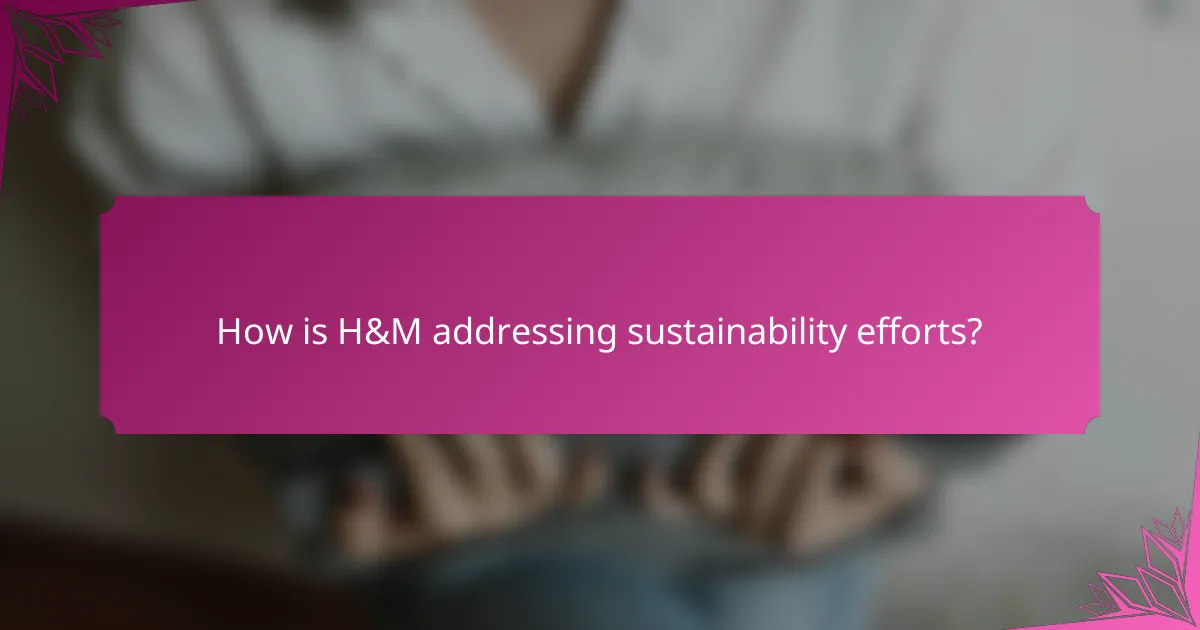
How is H&M addressing sustainability efforts?
H&M is addressing sustainability efforts by implementing various eco-friendly initiatives. The brand aims to use 100% sustainable cotton, linen, and polyester by 2025. H&M has also launched a garment collecting program to recycle old clothes. This initiative encourages customers to return used items for reuse or recycling. Additionally, H&M invests in innovative materials such as recycled fabrics. The company reports that over 60% of its products are made from sustainable materials. H&M’s commitment includes reducing greenhouse gas emissions across its supply chain. The brand has set a goal to achieve climate positivity by 2040.
What initiatives has H&M implemented for sustainability?
H&M has implemented several initiatives for sustainability. The brand has committed to using 100% sustainably sourced cotton by 2025. H&M also aims to make all of its products from recycled or other sustainably sourced materials by 2030. The company has launched a garment collecting program, encouraging customers to recycle their old clothes. H&M’s Conscious Collection features items made from sustainable materials. Additionally, the brand has invested in renewable energy for its operations. H&M reports that it has reduced greenhouse gas emissions in its own operations by 20% since 2015. These efforts demonstrate H&M’s commitment to improving sustainability in the fashion industry.
How effective are H&M’s recycling programs?
H&M’s recycling programs are moderately effective. The company has collected over 35,000 tons of textiles since the launch of its garment collecting initiative in 2013. This program encourages customers to return used clothing for recycling or reuse. H&M aims to use 100% recycled or sustainably sourced materials by 2030. However, critics argue that the overall impact is limited due to the scale of fast fashion production. A 2021 report indicated that only a small percentage of returned garments are actually recycled into new textiles. H&M continues to expand its recycling efforts, but challenges remain in achieving significant sustainability.
What sustainable materials is H&M incorporating into its products?
H&M is incorporating sustainable materials such as organic cotton, recycled polyester, and Tencel into its products. Organic cotton is grown without synthetic pesticides or fertilizers. This method reduces environmental impact and promotes biodiversity. Recycled polyester is made from post-consumer plastic bottles. It diverts waste from landfills and reduces the need for virgin materials. Tencel, made from sustainably sourced wood pulp, uses a closed-loop process that minimizes water and chemical use. H&M aims to use 100% sustainably sourced cotton by 2025. These efforts reflect H&M’s commitment to improving its sustainability practices in the fashion industry.
How does H&M communicate its sustainability efforts to consumers?
H&M communicates its sustainability efforts to consumers through various channels. The brand utilizes its website and social media platforms to share information about sustainable practices. H&M publishes annual sustainability reports detailing progress and goals. The company has launched campaigns highlighting eco-friendly collections made from recycled materials. In-store signage and labels provide consumers with information on product sustainability. H&M also engages in collaborations with environmental organizations to enhance credibility. The brand’s transparency in supply chain practices fosters consumer trust. H&M’s use of digital storytelling showcases the impact of sustainability initiatives. This multi-faceted approach effectively informs consumers about H&M’s commitment to sustainability.
What marketing strategies does H&M use to promote its sustainability initiatives?
H&M employs various marketing strategies to promote its sustainability initiatives. These include transparent communication about their sustainability goals. H&M shares information on its website and social media platforms. They highlight their use of sustainable materials and eco-friendly production practices. The brand also engages in collaborations with environmental organizations. H&M runs campaigns to encourage recycling and clothing donations. They utilize in-store promotions to educate customers on sustainability. Additionally, H&M releases annual sustainability reports detailing progress and goals. These strategies effectively enhance their brand image and consumer trust in sustainability efforts.
How transparent is H&M about its sustainability practices?
H&M is moderately transparent about its sustainability practices. The brand publishes an annual sustainability report detailing its goals and progress. H&M has committed to using 100% sustainably sourced materials by 2030. It provides information on its supply chain and the factories it works with. The brand also shares data on its carbon footprint reduction efforts. However, critics argue that some claims lack detailed verification. Independent assessments of H&M’s practices vary, indicating room for improvement in transparency. Overall, H&M takes steps towards openness but faces scrutiny regarding the depth of its disclosures.
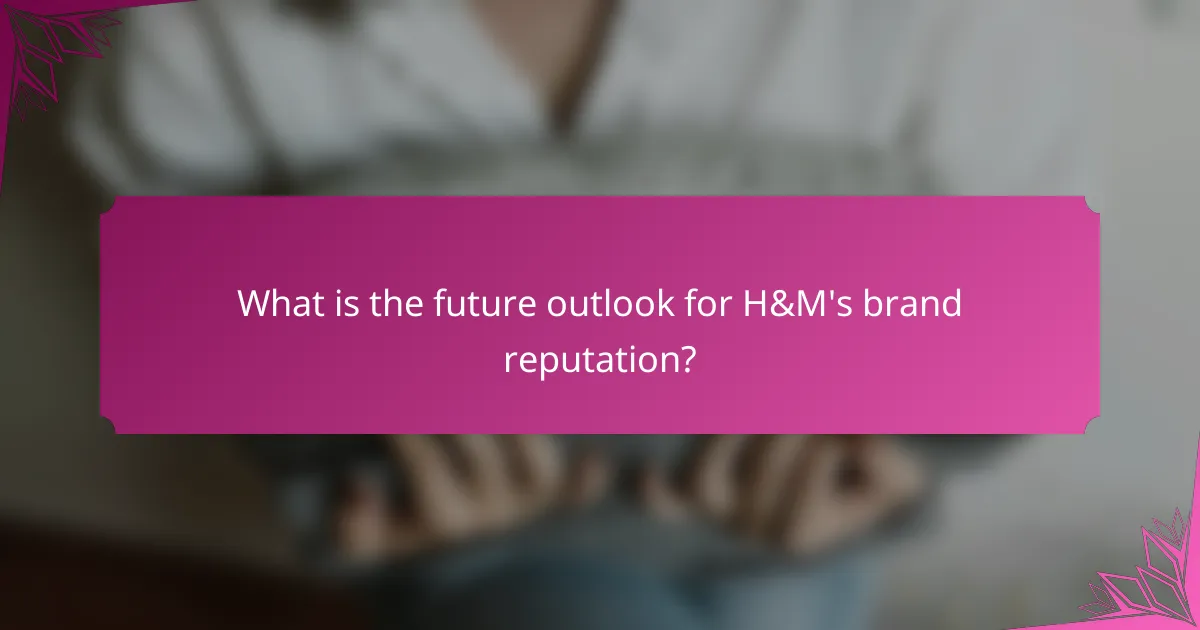
What is the future outlook for H&M’s brand reputation?
H&M’s brand reputation is likely to improve in the future. The company is increasingly focusing on sustainability and ethical practices. H&M has committed to using 100% sustainable cotton by 2025. They are also investing in recycling initiatives and circular fashion. Recent surveys indicate a growing consumer preference for ethically produced clothing. H&M’s transparency about supply chain practices is enhancing trust among consumers. Additionally, collaborations with eco-conscious designers are positively impacting public perception. Overall, H&M’s proactive measures in sustainability are expected to bolster its brand reputation moving forward.
How will changing consumer attitudes impact H&M’s reputation?
Changing consumer attitudes will significantly impact H&M’s reputation. As consumers increasingly prioritize sustainability, H&M may face scrutiny regarding its fast fashion practices. Negative perceptions could arise if the brand fails to align with ethical standards. Research shows that 66% of global consumers are willing to pay more for sustainable brands. H&M’s commitment to sustainability initiatives can enhance its reputation if effectively communicated. Conversely, any perceived greenwashing could damage trust among consumers. The brand’s ability to adapt to these shifting attitudes will be crucial for maintaining a positive reputation.
What trends in consumer behavior should H&M be aware of?
Consumers are increasingly prioritizing sustainability in their purchasing decisions. This trend reflects a growing awareness of environmental issues. Many shoppers are seeking brands that demonstrate ethical practices. H&M should note that transparency in sourcing and production is becoming essential. Additionally, consumers are gravitating towards second-hand and rental fashion options. This shift indicates a desire for more sustainable consumption patterns. Social media influences consumer preferences significantly, especially regarding brand values. According to a 2021 survey by McKinsey, 67% of consumers consider sustainability when making fashion purchases. H&M must adapt to these evolving behaviors to maintain its market position.
What best practices can H&M adopt to enhance its brand reputation?
H&M can enhance its brand reputation by adopting sustainable practices. Implementing a circular economy model can significantly reduce waste. For instance, H&M’s garment recycling program encourages customers to return old clothes. This initiative aligns with growing consumer demand for eco-friendly options. Transparency in supply chain practices is also crucial. H&M should disclose sourcing and labor conditions to build trust. Additionally, collaborating with environmental organizations can bolster credibility. Engaging in community initiatives demonstrates social responsibility. Regularly publishing sustainability reports can keep stakeholders informed. These actions collectively improve H&M’s public perception and brand loyalty.
How can H&M improve its ethical sourcing practices?
H&M can improve its ethical sourcing practices by increasing transparency in its supply chain. Implementing a traceability system for materials can help ensure ethical sourcing from suppliers. Engaging in regular audits of factories can identify labor conditions and compliance with ethical standards. Collaborating with third-party organizations can enhance credibility in ethical sourcing claims. Establishing long-term partnerships with suppliers can promote sustainable practices and fair wages. Investing in training programs for workers can improve their skills and working conditions. Lastly, setting measurable sustainability goals can track progress and demonstrate commitment to ethical sourcing.
What steps can H&M take to further its sustainability goals?
H&M can further its sustainability goals by increasing the use of recycled materials in its products. Currently, H&M aims to use 100% sustainable cotton by 2025. This includes organic, recycled, or otherwise sourced cotton. Additionally, H&M should enhance transparency in its supply chain. This can involve disclosing suppliers and their practices to ensure ethical sourcing. Investing in sustainable technologies for production processes is also crucial. For instance, using waterless dyeing techniques can significantly reduce water usage. Furthermore, H&M can promote circular fashion initiatives. This includes encouraging customers to recycle old garments through in-store collection programs. By implementing these steps, H&M can strengthen its commitment to sustainability and improve its brand reputation.
H&M is a prominent entity in the fast fashion industry, known for its trendy clothing at affordable prices. The article examines H&M’s brand reputation, highlighting the balance between its appeal and ethical scrutiny regarding labor practices and environmental impact. It discusses the evolution of H&M’s reputation over time, key events influencing public perception, and the significant role of consumer attitudes towards sustainability. Additionally, the article outlines H&M’s sustainability initiatives, ethical sourcing practices, and the challenges faced in improving its brand image amidst ongoing criticism.
